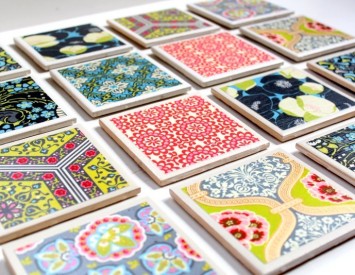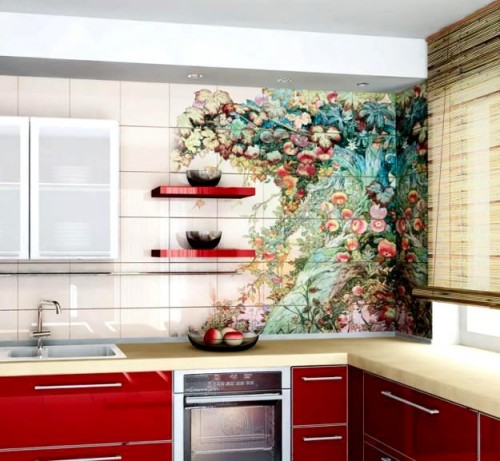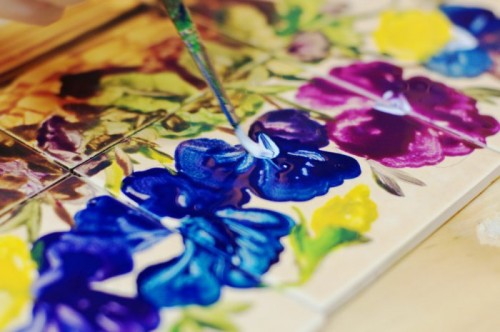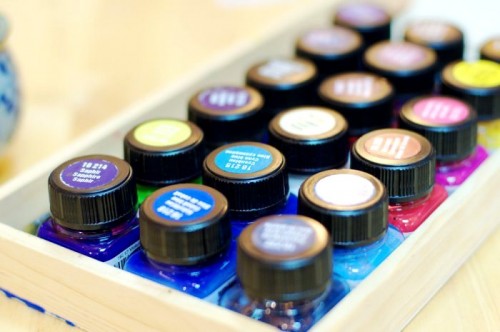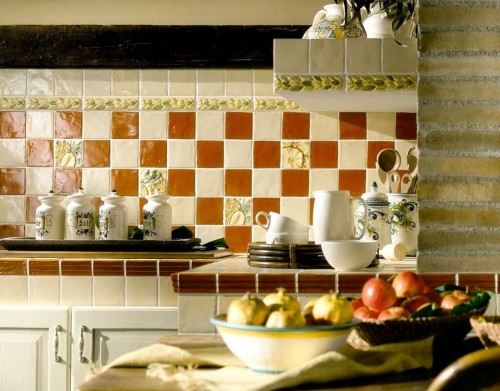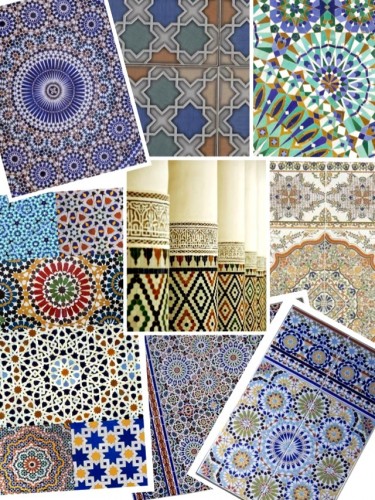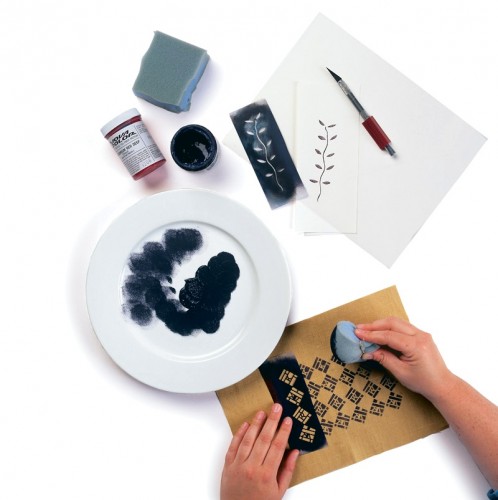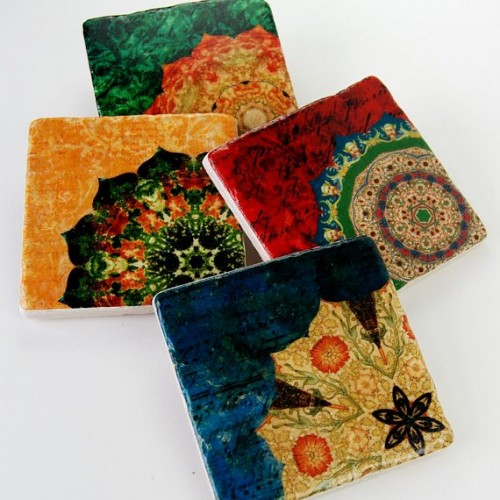In the modern segment of building materials, there is a huge variety of colors of ceramic tiles. However, despite this choice, the creation of a decor with your own hands is relevant. One of the ways to show imagination and creativity, to create an original interior on your own is the decoupage of tiles.
Content
Features of the decoration methodology
Decoupage is an artistic technique that involves gluing on a wide variety of objects of individual patterns, as well as entire paintings. The name of this technique translated from French means “cut”. Despite the fact that this type of creativity arose in China, this trend came to Europe only in the 17th century as an art for the poor. The peasants could not afford to decorate their housing with an expensive finish, as a result of which the decoupage technique arose. However, modern designers widely use the decor methodology and use it in a wide variety.
Today, the trend is gaining popularity to decorate ceramic tiles by decoupage. This makes it possible to update and decorate the situation of the premises without performing labor -intensive repair work for this.
The material for decoupage on ceramic tiles can be napkins, wrapping paper, various illustrations from print media and even labels. Recently, materials such as printing prints have become significant popularity. In this way, you can decorate a wide variety of objects, without applying significant efforts. In addition, decoupage can be done with minimal financial costs.
Ways to perform decoupage
Experts distinguish many options for decoupage, but the most popular today are the following:
- The location of one image on several tiles.
- Selective drawing.
- The use of several patterns at the same time.
- Placement on each tile of the same print.
- The combination of the image on the tile with the decoration of other surfaces and parts in the interior of the room.
Decoupage on ceramic tiles photo:
Required materials and tools
If you decide to make decoupage on ceramic tiles, this lesson will not be much trouble and will not require significant financial costs. To perform the decor, you must prepare the following:
- paper, it is desirable that it be as thin as possible;
- a napkin with a selected image;
- a brush for applying a picture;
- paint based on acrylic and lacquer-acrylic-American, polyurethane or uretan;
- ceramic tiles;
- small scissors;
- acetone or alcohol;
- glue.
Important! When choosing a tile, it should be noted that the size of the working surface should be sufficient to accommodate the planned pattern.
Finding all the necessary materials will not be difficult. Today, many specialized stores offer such products separately or in the kit. Contact art, stationery, as well as in construction markets.
Recommendations before starting work
Decoupage of ceramic tiles The master class requires compliance with certain subtleties and features that will allow the entire process as carefully and aesthetically as possible. Let us consider in more detail the recommendations for the implementation of the decoration technique:
- When cutting a pattern of material for decor, small scissors with rounded ends are well suited - manicure, as well as medical ones.
- If dense paper is used, a knife specially designed for decoupage should be used, in addition, a scalpel is suitable.
- In the presence of small details in the image, you can cut larger ones, and finish the rest of the fragments.
- To glue the picture, it is recommended to use a special adhesive for decoupage. But if this is not available, it is permissible to use the usual composition of PVA, as well as glue from egg protein, previously diluted with manicure varnish or wallpaper glue.
- When using the napkin, the first two layers should be removed from it, leaving only the last on which the pattern is located.
- The napkin is applied to the surface and glued with a flat brush. The glue is applied from the outside.
- It must be taken into account that the napkin impregnated with the adhesive will stretch, as a result of which, with insufficient accuracy, it can break.
- If paper specially designed for declarations is used, before use it must be soaked for 1 minute in water. In this case, the glue should be applied from the inside. After gluing from above, you can cover with another layer of adhesive.
- If the drawing is printed on a printer, then it is advisable to apply a little hair varnish on paper. This will prevent the vague of paints.
- For decoupage, it is customary to use acrylic paints. They dry out quite quickly and do not dissolve when water enters the image.
- At the end of the work, the product should be covered with varnish to create a protective layer from possible damage. Depending on the type of varnish, you can get a matte or shiny surface effect. For these purposes, varnish based on acrylic is well suited.
- The number of layers can be different. We apply the varnish until the picture is merged with the decorated item.
The technology of decoupage
Creating decoupage on ceramic tiles with your own hands – a scrupulous, but quite interesting activity that will add a note of originality and the innovation of the author’s idea to the everyday interior of the dwelling. In order for the work to be completed as efficiently and accurately as possible, it is necessary to follow this order of actions:
- At the first stage, it is necessary to determine the pattern that will be transferred to the tile. When choosing an image, one should be guided by the indicator how harmoniously the pattern or the picture will fit into the overall interior of the room. And, of course, with his preferences and tastes.
- Then, if we are talking about a printed print, the drawing must be processed in a graphic editor. It can be Photo Shop. In the process of processing, the image should be adjusted in accordance with the necessary sizes. In other words, increase or reduce it, adjust brightness and contrast. After that, using the functions of the program, it is necessary to cut the image into the required number of individual fragments. Then we save each part in a separate file, while leaving 5 mm from all sides.
- At the next stage of the process, it is necessary to print all parts of the picture using translucent paper. At the same time, trapping should be glued on paper. After all parts of the picture are printed, we disconnect them from paper and get rid of unnecessary details.
- Next, go directly to the gluing of the image. In order for the pattern to be firmly attached to the surface of the tile, it must be thoroughly degreased. For this purpose, medical alcohol or acetone is suitable.
- Then, using a brush, lubricate all fragments with glue. It is necessary to ensure that the paper is completely saturated and only after that we apply it to the front side of the tile.
- We fasten the paper to the surface of the tile with smooth movements, moving towards the center to the edges.
- You should also eliminate air bubbles and possible tubercles. This stage is very important, since the presence of bubbles and irregularities can lead to the fact that the paper will tear. We wait for the time to dry the product.
- Next, it is necessary to turn on the oven for a mode of 170 ° C and put the tile inside for 30 minutes. After the specified time, turn off the oven, but do not pull out ceramic fragments until the oven cools down. Otherwise, due to a sharp temperature difference, the product may crack or split.
- Then it is necessary to apply another layer of acrylic paint to the surface of the tile and put in the oven again. But this time the heating time will be 10 minutes.
After cooling the product, its surface is recommended to be covered with varnish in two layers. This will contribute to prolonged operation and low exposure to abrasion and damage.
Stencil technique in decoupage
You can perform the decoupage of tiles with the help of a stencil. This is a simpler and less costly method that guarantees a successful result even to a novice master. To do this, prepare the following materials:
- monophonic tiles;
- stencils with the desired pattern;
- acrylic paints;
- aerosol glue with which stencil is well attached to the tile;
- brushes of various sizes;
- sponges.
The process of doing work is as follows:
- First you need to clean the surface of the tiles of pollution. To do this, rinse fragments in water using a dishwasher. You can also wipe with alcohol.
- The tile should dry. At this time, we prepare a stencil. We apply aerosol glue on its back. This will help to fix the stencil during work.
- After the tile is dried, we put the stencil on its outer surface and you can start work.
- When choosing a color scheme for the future drawing, it is recommended to take into account one moment. The product will look more profitable if the previous shade is the darker of the subsequent.
- Next, we proceed directly to the application of the picture. To do this, you can use a brush or a regular sponge. In the process, the brush should be kept perpendicular, and apply the paint with point movements. Otherwise, the paint will flow under the stencil and the drawing will eventually turn out to be fuzzy.
- To achieve various design effects, you can also apply an image with a sponge that will create roughness in the figure.
- After the image is applied, you can remove a stencil. Then you need to wait a few hours so that the paint can completely dry.
There are many options for using stencils for decorating tiles. Tiles can be used during the repair and thereby introduced exclusive notes into the interior. You can attach the felt part of the felt on the back and get a convenient and practical stand for dishes. Another option is also possible - to determine the tile into the frame and so get the picture. You can decorate the already laid tile.
By showing creative abilities with the help of decoupage technology, you can diversify the interior with your own hands, as well as make it exclusive and original. And this will not require significant financial costs or a lot of free time.
You can see the technique of decoupage on ceramic tiles on the video in a fragment below:
